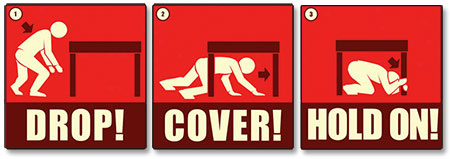Instructions to take in the event of an Earthquake
Common sense preparedness before an Earthquake
- To increase stability, load filing cabinets and bookcases from the bottom up with heaviest items on the bottom.
- Have the Facilities Department brace, anchor, or fasten tall or top-heavy objects to the wall.
- Arrange desks and furniture so that you are not sitting under open bookshelves, or where tall furniture or objects could fall on you.
- Have a 72-hour kit and comfortable walking shoes at your work site or in the trunk of your car.
If you are INDOORS during an Earthquake

- Stay inside. Falling debris from buildings can cause serious injury.
- Stop what you are doing, DROP to the ground and take COVER under sturdy desk, table, or other furniture, or along an inside wall. Protect your head and your neck by placing your hands and arms on your head. HOLD ON to your cover as it may shift and move. Do not leave cover until the shaking stops.
- Stay away from windows and other glass objects.
- When tremors stop, leave the building and follow the instructions of campus emergency officials.
- Do not use the elevators.
If you are OUTSIDE during an Earthquake
- Move away from buildings and utility wires. Once in the open stay there until the tremors stop.
- Stay outside!
If you are IN A MOVING VEHICLE during an earthquake
- Stop as quickly as safety permits.
- Remain in the vehicle.
- When tremors stop, drive on carefully watching for falling objects, downed electrical wires, and broken or undermined roadways
- Avoid roads, bridges, or ramps that the earthquake may have damaged.
After an Earthquake
- Be prepared for additional aftershocks. They are usually smaller, but can cause additional damage or bring weakened structures down.
- Do not attempt to move seriously injured persons unless they are in immediate danger of further injury. Report the location of the injured person to emergency personnel.
- A campus emergency response team will assess the damage as quickly as possible and provide further instructions. The CERT team members will be recognizable in green vests and hard hats and wear emergency response picture ID’s.
- Do not use candles or lighters, etc., in the event of gas leaks.
- Do not enter buildings until structural safety can be assessed by trained personnel.